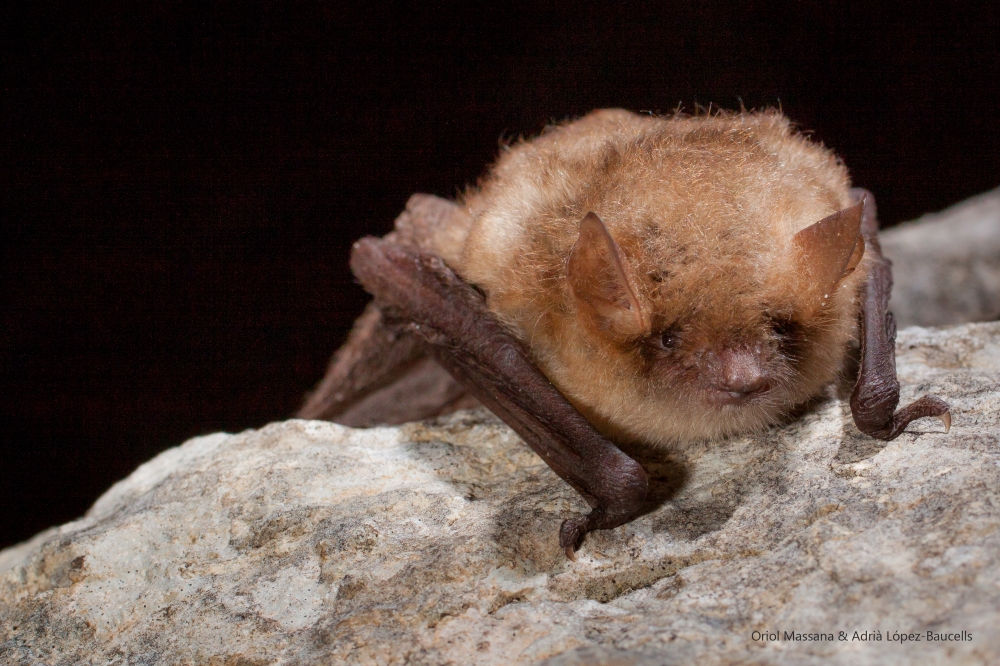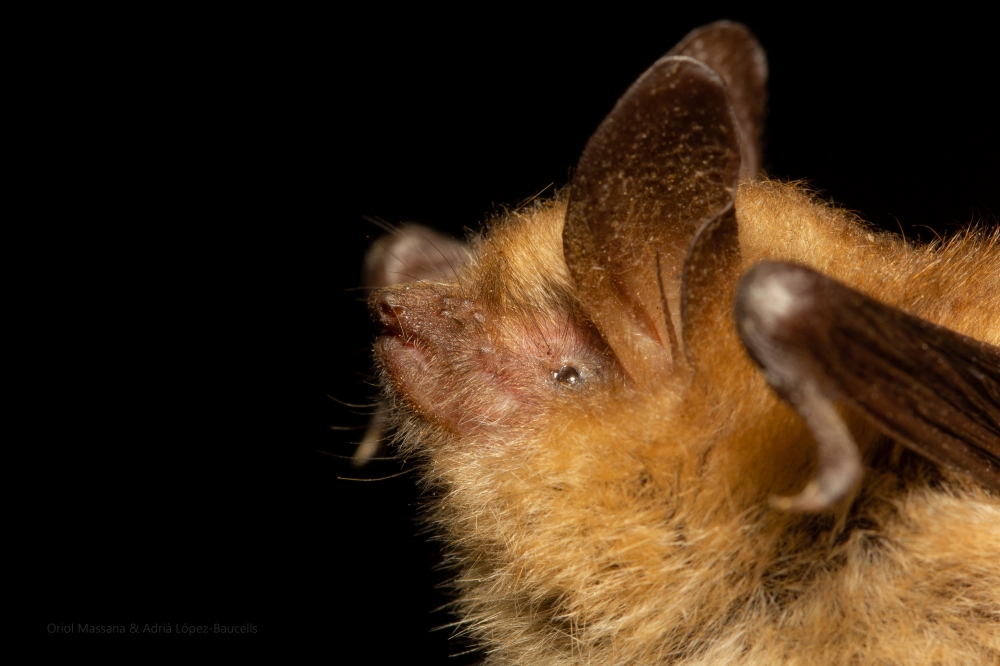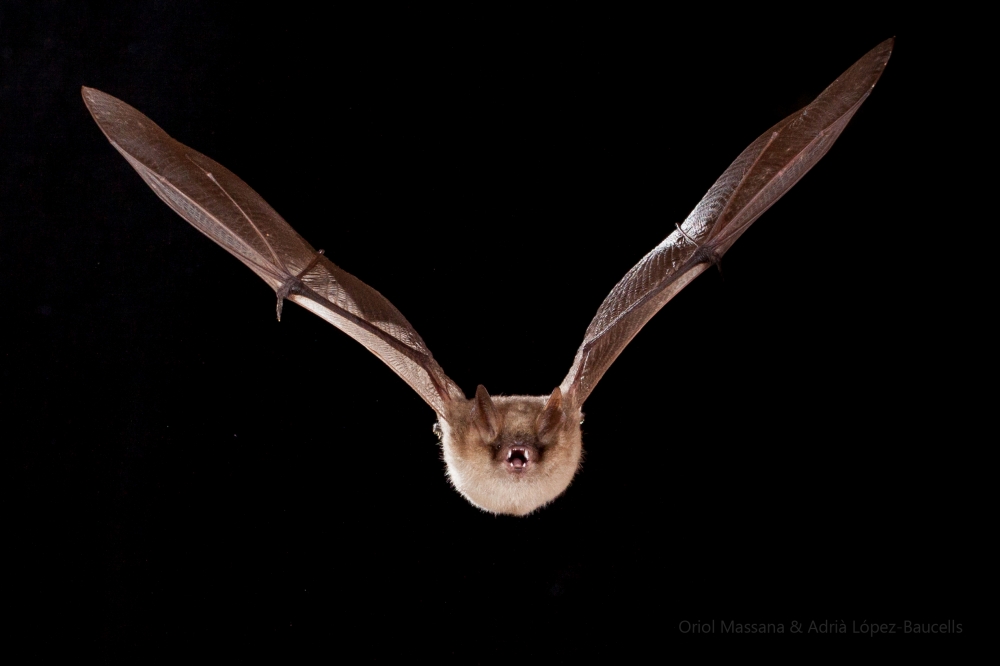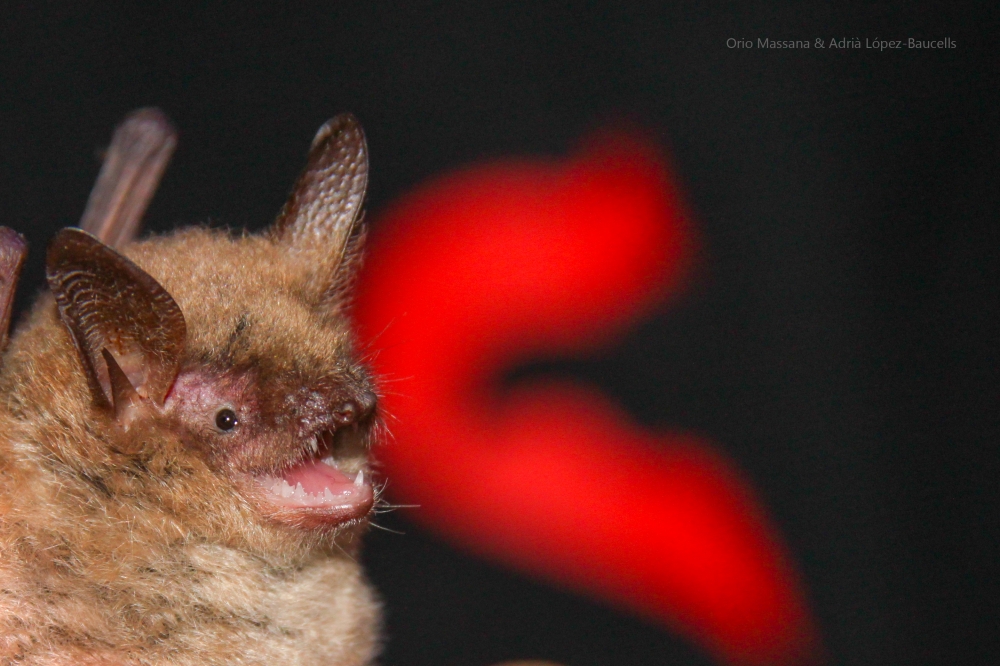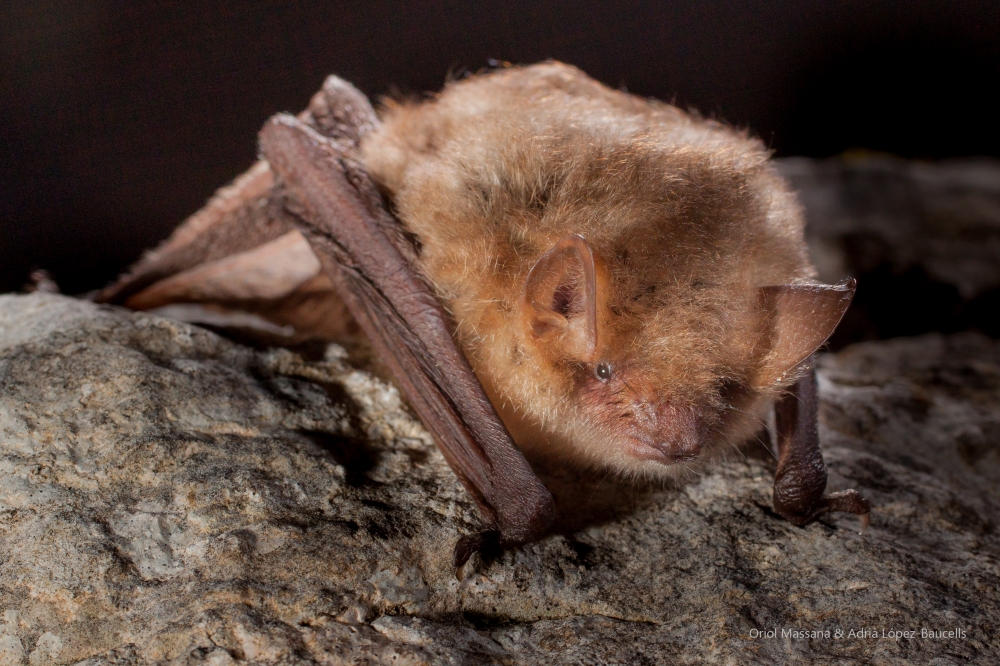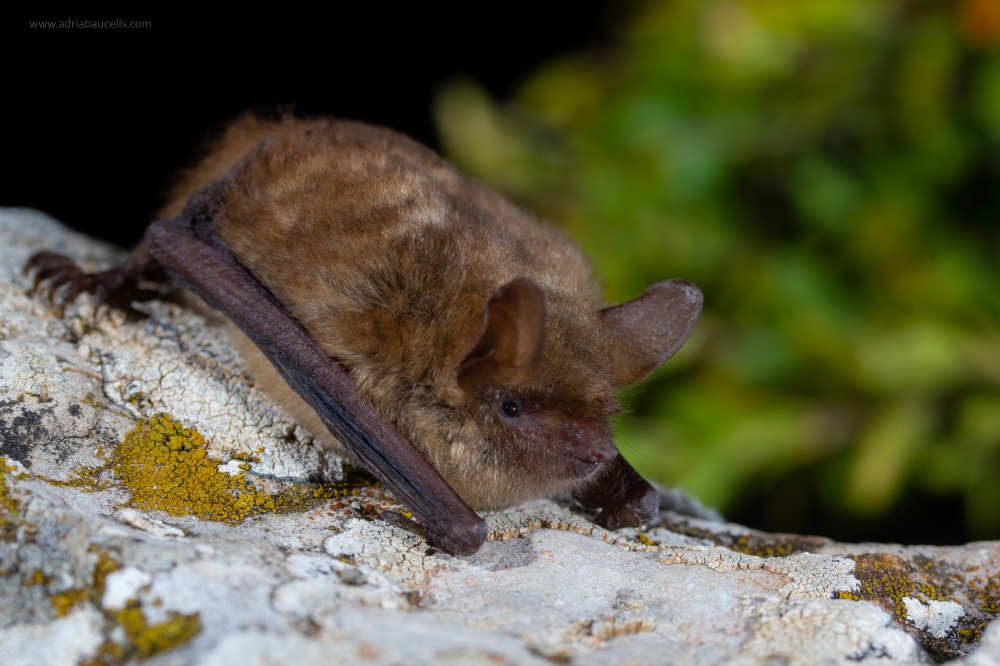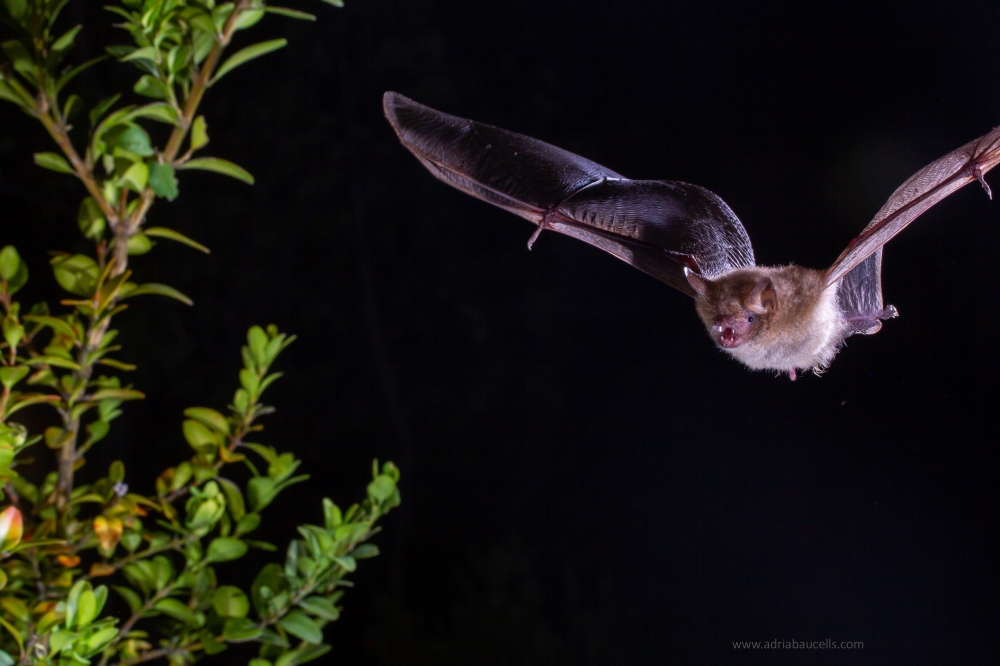Geoffroy's bat
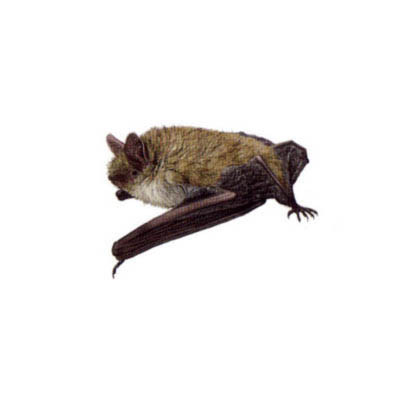
Myotis emarginatus (Geoffroy, 1806)
Vespertilionidae
Least Concern
| Other names | |
|---|---|
| Catalan | Rater d'orelles dentades |
| Spanish | Murciélago ratonero pardo |
| English | Geoffroy's bat |
| French | Murin à oreilles échancrées |
| Basque | Geoffroy saguzar |
| Galician | Morcego de orellas fenidas |
Description
Medium-sized bat with a length ranging from 41 to 54 mm (head and body), a forearm measuring between 36 and 44 mm, a wingspan of 220 to 250 mm, a tail measuring 38 to 46 mm, and a weight ranging from 5.5 to 15.5 g. The ears, face, and wings share the same colour, being brown or light brown. The ears are elongated (15 to 17 mm) and have a distinctive indentation on the outer margin that gives it its name, along with a straight and fine tragus. The fur is long and woolly, with a characteristic reddish-brown colour that can vary from brown to reddish, with the ventral part slightly more yellowish or whitish. Juveniles have darker colourations than adults.
It is distinguished from gray bats (Myotis nattereri, M. escalerai, and M. crypticus) by its reddish colouration, straight and shorter calcar, its characteristic ear indentation, and a much shorter and less noticeable uropatagium hair fringe.
Fotografies
Distribution
This species is characteristic of Southern Europe, especially the Mediterranean area, including most islands. To the north, it reaches Northern Belgium, the south of the Netherlands, and Poland. In Germany, it only appears in the warmer regions. It can be found from Portugal to Western Europe, including the Caucasus region, Syria, Iraq, Turkey, Palestine, Lebanon, Oman, Tajikistan, and Uzbekistan. Also, in Northwest Africa, the Middle East, and the Arabian Peninsula.
Roosts and phenology
Summer roosts in the northern part of its distribution are often associated with buildings, typically in church attics, houses, and livestock sheds. They usually occupy relatively bright and cool attics. In the south, particularly in caves, although there are also breeding colonies in abandoned buildings such as farmhouses. Isolated individuals may use various shelters, including rock crevices and tree holes, in addition to those mentioned. Maternity colonies are often used for several generations and can contain 20 to 500 females and some males, typically mixed with other species like the greater horseshoe bat (Rhinolophus ferrumequinum). In some cases, such as at the border between Greece and Bulgaria, there are breeding colonies of 7,000 individuals. Pups are born from mid-June to mid-July. Breeding colonies are usually abandoned in August.
Females do not typically mate during their first year of life. Mating occurs roosts between August and September, where "swarming" behavior is observed, with males being much more abundant in these places. It is essentially a sedentary species, with a distance between breeding and hibernation roosts of about 40 km. The longest documented movement is 105 km. In winter, it uses underground roosts with relatively high and constant temperatures of about 13°C. Hibernation for this species is unusually long, extending into April in southern Germany, with some individuals extending it until mid-May.
Habitat and diet
It is generally found in forested environments and habitats with low vegetation such as shrublands where climatic conditions are favorable. It can be found from sea level up to 1,800 meters. Hunting areas include deciduous forests, open horticultural areas, parks, and naturalized gardens. It typically prefers highly structured forests with a high diversity of shrub and tree species over coniferous forests.
This species specializes in hunting mainly spiders and harvestmen, although to a lesser extent, it also feeds on flies and moths. In Central Europe, it often visits shepherd's huts during the breeding season in search of flies and other flying dipterans. Hymenopterans and beetles make up a very small part of its diet. It usually hunts very close to vegetation as well as above trees, catching prey directly from the vegetation. Spiders are captured directly from their webs, and insects can be taken from ceilings or walls where they rest. It avoids open areas for hunting.
Echolocation
The echolocation calls are very similar to those of other species in the Myotis genus. It produces short calls of about 1 to 3 ms, highly modulated (FM). They typically start at high frequencies, around 140 kHz, and decrease to 38 kHz. The frequency of maximum intensity is distributed between 40 and 70 kHz. Like other small Myotis species, it falls into the phonic group Myotis 50. Recently, it has been observed that its calls with a wide frequency range could be used to distinguish them from other Myotis species.
Trends
| General trend | Uncertain |
|---|---|
| Protocol | ChiroRoosts |
| Period | Reproduction |
| Geographic scope | Catalonia |
| Number of localities studied | 17 |
| Annual change | -3.3 % |
| Method | TRIM |
| Analysis execution date | 01/09/2024 |
Status
According to the IUCN Red List, it is classified as Least Concern, with a stable population trend. It is protected by national laws in various countries, as well as by the Eurobats Agreement, the Bern Convention, and the European Habitats and Species Directive. Depending on the country, it may be categorized as a rare or common species. Over the past decades, the number of individuals has decreased, but currently, the population seems to be recovering. In Germany, the population is stable, and in the Netherlands, the population appears to be growing. The main threats to this species seem to be habitat fragmentation by roads and highways and the destruction of its roosts. The use of parasiticides in livestock may also impact prey availability.
